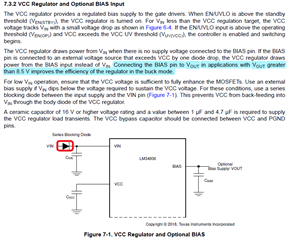Hi support team,
Should BIAS be connected to VOUT when used under the following conditions?
Vin: 10~17V
Vout: 12V
Iout: 3~4A
If so, is a diode on VIN unnecessary?

Regards,
Dice-K
This thread has been locked.
If you have a related question, please click the "Ask a related question" button in the top right corner. The newly created question will be automatically linked to this question.
Hi support team,
Should BIAS be connected to VOUT when used under the following conditions?
Vin: 10~17V
Vout: 12V
Iout: 3~4A
If so, is a diode on VIN unnecessary?

Regards,
Dice-K
Hello Dice-K,
It depends on how often the input voltage is above the output voltage. The power dissipation is higher if BIAS is connected to a higher voltage. So dependent on your input voltage profile, it is better to connect BIAS to VIN or VOUT.
If BIAS is connected to VOUT, the diode is necessary.
Best regards,
Brigitte
Hi Brigitte,
Thank you for your support.
I correct the input voltage range.
Vin: 10~18V
Vout: 12V
Iout: 3~4A
The input voltage is often ratio higher than 12V.
When using a battery, it will drop from 16.8V, and below 12V will be close to the final voltage.
On the other hand, when supplied from an external DC power supply, a constant 17.7V is supplied.
Is it best to connect BIAS to VOUT in this case?
(Will it be more efficient than leaving BIAS open?)
I also think we will need a diode on VIN.
What are the specs and ratings required for a diode?
Best regards,
Dice-K
Hello Dice-K,
If mostly the output voltage is smaller than the input voltage, it is more efficient to connect BIAS to VOUT as the linear regulator internally for VCC will have less power dissipation.
The diode with 1A current rating and somewhat higher voltage rating than the maximum input voltage is sufficient. See the EVM for an example.
Best regards,
Brigitte